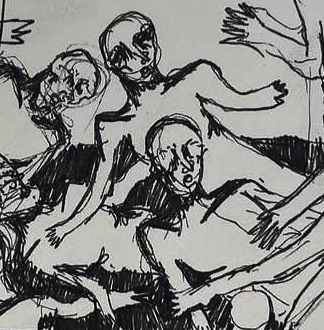Social media has always been one of my main interests and checking what's new on media websites is a significant part of my daily activities. It amazes me how fast news and ideas spread around the world. Recently, one of the social media campaigns that captured my attention and a LOT of other people is the #10yearschallenge.
It calls on people everywhere, especially celebrities, to share decade-old photos of themselves, showing their change over the years. I had never participated in the challenge because I hadn't found a photo of myself from 2009. But I decided on another way to participate, which I think is more effective since it has more meaning than just fun. Below are my designs with my comments. Enjoy!
* * *

Along with other Palestinian children in Gaza, I considered 2008 to be the worst year ever, since it ended with the launch of a war against us that killed hundreds of neighbors and friends. At 12 years old, I found myself comparing New Year’s Eve in Gaza to others around the world: We feared the drop of phosphorous bombs, while people elsewhere celebrated with fireworks!
I was a strong girl, but I lived in fear of losing the people I loved, or even my own life, during that 22-day attack.
In 2018, the Israelis clashed with us once again. The Great Return March was launched in March of that year, to remind the world that we still wait for our right to return to the ancestral homelands from which we were evicted when Israel was created. When the year began, I was stronger than I was in 2009, yet I overwhelmed with sorrow and a feeling of powerlessness while I covered the Friday protests as a part of my work as Social Media Coordinator for We Are Not Numbers. My people are suffering so many losses just to demand their human rights, and I wish I could do something that would finally bring us justice.
* * *

All deaths are tragic, but somehow, the loss of babies and little children are the hardest to bear. They had only just begun to live! In the Israeli war on Gaza that began in December 2008, at least 579 Palestinian children were killed. I will never forget the times my father asked me to go to my room so I wouldn’t see the photos of dead or wounded children on TV. It's 10 years later, and my heart is aches as more and more children and youth are targeted by Israeli snipers during the border protests. As of today, 44 minors had been killed since the march began March 30, 2018. The most-recent child victim was Abdulraouf Salha, 14, who succumbed to his wounds on January 14.
* * *

Another thing that hasn't changed much in 10 years is the electricity crisis in Gaza. In 2008, we had electricity only for three to four hours a day, after 24 hours of cuts. It was so difficult to stay in touch with the outside world, or even to get information about what was going on inside Gaza. During the Israeli war on Gaza that began that December, we would hear the explosions and depend on a mobile radio to get the news about what was happening.
Nowadays, things are a little bit better. Still, we enjoy only six hours of electricity a day and it's still hard to study, work or do our daily chores. The reality that my days are controlled by the electricity schedule drives me crazy!
* * *

These photos show a significant difference in the plaza around the Al-Aqsa Mosque in Jerusalem. But I think only Palestinians notice. This holy yard used to be full of praying Muslims, especially on Fridays. It makes me sad and worried nowadays to read – almost everyday – news of Israeli settlers raiding these Muslim holy places. The expansion of fences and other security measures around the Al-Aqsa compound scares and depresses me. Fewer and fewer Muslims can realize the dream of praying in this holiest of mosques.
* * *

In 2009, Israeli warplanes struck all over the Gaza Strip. ِAlmost 2,358 houses were destroyed and another 13,644 were damaged. Hence, a great number of Gaza’s residents became homeless and sought shelter in U.N. schools or shared houses with their relatives. For most, it felt like they were forced to emigrate inside their own land.
Today, thousands of Gazans have left the Strip voluntarily to look for a better life. They had no hope life would ever be better if they did not leave their homes and extended families behind, taking great risks to try to find work elsewhere. Surveys show that more than a third of young people in Gaza would immigrate if they had the chance. Will there come a time when all I see around me are old people and children?
* * *

My lovely hometown, Gaza City, has a place that all of its citizens see as a refuge when life gets too hard. It's the sea port. We love to visit whenever we can, and there we spend the most precious family times. The port hasn’t changed during the last decade; it still unites people across different classes, religions and perspectives.
Thinking of all our troubles makes Gazans feel hopeless, depressed and worried about what the next years will hold. But I choose to be hopeful, imagining how would my sad city would look if everything went as we wished. In my imagination, Gaza will be similar to Singapore in 2029! The sea will be clean. The buildings will be new and free of holes from missiles. Garbage will be cleared away and processed safely. Children will romp in safe playgrounds and their parents will not be as poor and depressed as they are now. The people of Gaza will be proud of themselves and their city, and no matter where they go, they will return!










